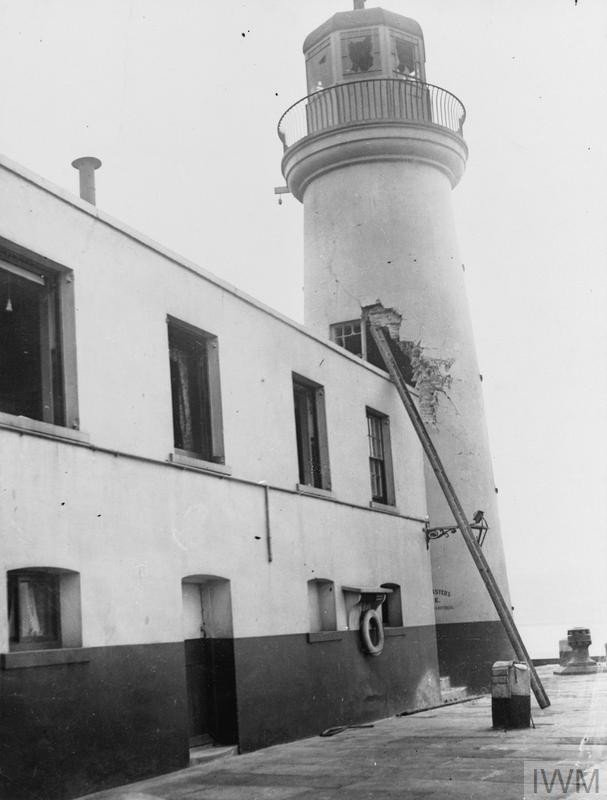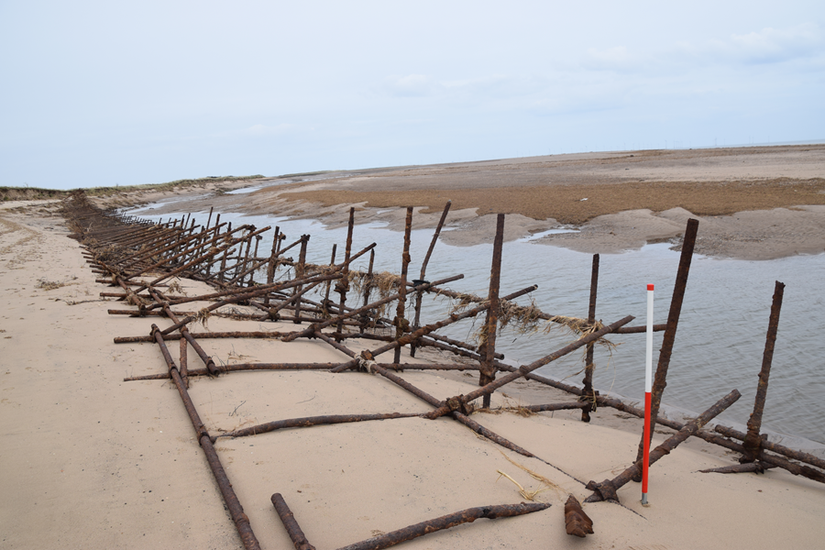Scouting at Gibraltar Point
14/06/2024 | Andy Sherman
Gibraltar Point is located just two miles south of Skegness and today is a tranquil, picturesque stretch of sand dune and marsh grass protected as a nature reserve. In the middle of the 1800's it was at the heart of a maritime landscape with an anchorage close by, an inn providing hot food and shelter to weary sailors, and a coastguard station. By the mid-19th century Wainfleet Haven had become an important stopping place for coastal traders where goods coming to and from Wainfleet were loaded onto smaller barges and transported up the River Steeping. This is turn led to a coastguard station being built in 1858, initially to monitor the ships and goods being transferred back and forth, and then increasingly becoming about the protection of lives at sea. A sub-station of the larger coastguard centre at Skegness it was originally staffed by three single men, each working an 8-hour shift, before being permanently occupied by a married family.1 The brick wall that partially surrounds the building would have originally encompassed the whole site, protecting it from flooding, and on a particularly high tide the water still laps around the bottom of the wall. Not only does the wall protect the building from an occasional lick by the tide, it also highlights a little known episode in the site's war time record. Scratched into the brickwork are the names of several Boy Scouts from Northampton, who were station at Gibraltar Point in the spring of 1915. But what were Boy Scouts doing at Coastguard station during the First World War?

The Boy Scouts Association was established by Lord Robert Baden-Powell in 1910, following his first camp for boys three years earlier on Brownsea Island, in Poole Harbour. Baden-Powell wanted to teach young boys skills in self-reliance, leadership, and bushcraft. [The Girl Guides Association was formed by Baden-Powell in 1910 and run by his sister Agnes and wife Olave.] When the First World War engulfed Europe in 1914 Baden-Powell felt that the Boy Scouts, he had been training were well placed to do 'their bit' and assist their elders in defending the country by supporting essential services around Britain.
Baden-Powell directly contacted every Scouting District Commissioner in Britain by telegraph in the first week of August 1914, requesting his sub-ordinates immediately recruit their boys for the war effort. The telegraph to Lord Leigh on the 4th August was published in the local press: "Hope you can supply 1,000 scouts ... to aid local civil or defence authority ... War Office informed."2 A year later recruitment posters specifically designed to reach out to Boy Scouts, were spread across the country, encouraging them to sign up for war work, if they were too young to fight.

By the end of the summer of 1914 executive committees were being set up around Britain to supply Boy Scouts for "useful service ... under the supervision of the Admiralty."3 It was this 'useful service' that would see patrols of Boy Scouts stationed at Gibraltar Point throughout the war years. However, it wasn't just the Admiralty utilising the services of the Scouting Movement, the army, post office, and police forces around the UK were putting their services to use. At the turn of year it was estimated that 100,000 boys had been deployed on active service. In Kent the young volunteers were given a variety of jobs.
"Among other work upon which they are now engaged may be mentioned the guarding of main telegraph and telephone cables, with instructions to report immediately if they are tampered with. One of the most important duties in this concern is to keep vigilant watch to see that the lines are not tapped. ... In Kent alone about 1,000 Scouts are keeping guard at bridges, stations, and culverts, while 2,000 are guarding telegraph and telephone cables and others rendering various assistance to the police. ... Scouts are also in camp by every coastguard station."4 While the London News Agency estimated that roughly 2,000 Boy Scouts were assisting the Metropolitan Police in London with everything from running messages to crowd control.
The use of Boy Scouts in public service wasn't without it's critics though, with the Board of Education arguing that boys of school age should not be employed [in 1914 the school leaving age was just 12!] "until the available supply of boys who have left school is clearly shown to be insufficient."5
In the first year of the war the Admiralty estimated that 1,400 boys had stationed around Britain's shoreline doing Coastguard duty in place of men who had joined the Fleet, with the Admiralty expressing "their satisfaction with the work they [the Boy Scouts] had done."6
Sadly this work wasn't without its risks and on the 16th December, George Taylor, a 15-year-old volunteer on coast-watch, became the only active member of the Boy Scouts to die during the War. He was killed in Scarborough when the Imperial German Navy shelled four ports along the North-East coast. Tragically George had left the Coastguard lookout to buy a newspaper when he was cut down by the naval gunfire. The lookout post was destroyed during the bombardment, but all the other occupants survived unhurt.7

While on coast-watch the Boy Scouts were nominally supervised by a member of the Coastguard, but under orders from their own Patrol Leaders, who were responsible for tasking their unit with useful work. None of the Scouts were paid, however a basic subsistence allowance was provided to each patrol so they could provision their encampments.8

The graffiti scratched into the coastguard station's wall tells us that Boy Scouts from Northampton were based there during May 1915. They likely put their semaphore knowledge to good use, signalling to other stations up and down the coast, as well as relaying messages to passing navy ships. Today the coastguard stations’ lookout tower is two storeys in height, but in the 1910's was only a single storey. Unfortunately, this wasn't tall enough to see over the dunes that had developed between the tower and the coast to the east of the station. So, the Scouts built a bridge across one of nearby creeks to enable them to access the top of the East Dunes and signalled from there.
At the end of the war the then Prime Minister of Great Britain, David Lloyd George, recognised the contribution of the Boy Scouts to the war effort on the Home Front in a speech, stating:
"It’s no small matter to be proud of, that the Association was able within a month of the outbreak of war to give the most energy and intelligent help in all kinds of service. When the boyhood of a nation can give such practical proofs of its honour, straightness and loyalty there is not much danger of that nation going under, for these boys are in training to render service to their country as leaders in all walks of life in the future."9
The Scout's graffiti is not the only relic of the First and Second World Wars at Gibraltar Point, with the area been heavily used during both conflicts. Remains of a coastal artillery battery can be seen dotted around the reserve, as can abandoned fragments of anti-invasion defences. The sand dunes were also used to train infantry and formed part of tank firing range. On the beach a short distance from the coastguard station, a rare example of surviving in situ Z1 Admiralty scaffolding can be seen. This was an anti-landing obstacle constructed from scaffolding poles, which was intended to prevent enemy landing craft approaching the beach. Designed and erected around the country in the early years of the Second World War it was mostly dismantled after 1945 on other stretches of the coast. Here it was protected by a covering of sand dune which had risen over the scaffolding after it had been built. In the last few years the changing course of one of the creeks spilling onto the beach has started to expose this metal relic, which is now slowly being eroded by the sea.

1) Wilkinson B, 2018 The story of Gibraltar Point
2) 'Lord Leigh's appeal for Scouts', Kenilworth Advertiser, 08-08-1914, p5
3) 'Boy Scouts and the War', Stockton Herald, South Durham, and Cleveland Advertiser, 15-08-1914, p4
4) 'Useful service performed by Boy Scouts', Penistone, Stockbridge and Hoyland Express, 15-08-1914, p6
5) 'Bar on Boy Scouts', Kenilworth Advertiser, 03-10-1914, p3
6) 'Guarding our coasts', Stockton Herald, South Durham, and Cleveland Advertiser, 26-12-1914, p6
7) 'Forgotten Friday - Scarborough Bombardment', Eden Camp - Modern History Museum, 17-12-2021 https://edencamp.co.uk/blog/forgottenfriday-scarboroughbombardment/
8) 'The shelling of Scarborough in 1914', English Heritage, https://www.english-heritage.org.uk/visit/places/scarborough-castle/history/shelling-of-scarborough/
9) 'Scouts on the Home Front 1914-1918', The Scout Association, https://www.scouts.org.uk/about-us/our-history/our-online-exhibitions/scouting-in-the-first-world-war/scouting-on-home-front-1914-1918/








